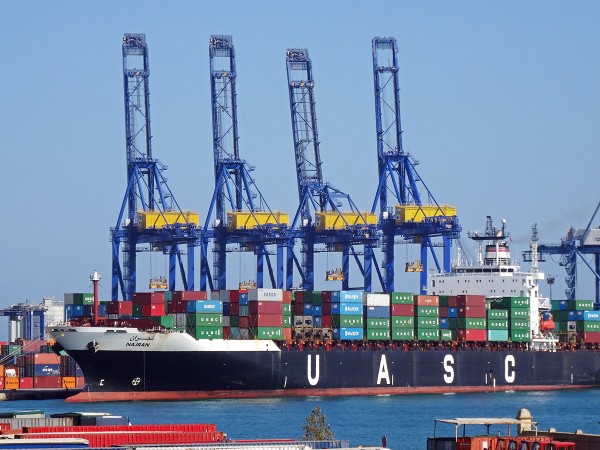 Newspaper headlines this week read that the UK’s balance of trade deficit has widened to £34.8bn, the largest since 2010. And when you exclude services, the trade in goods deficit, at £119.9bn is the largest ever in nominal terms and is also likely to be the largest as a percentage of GDP.
Newspaper headlines this week read that the UK’s balance of trade deficit has widened to £34.8bn, the largest since 2010. And when you exclude services, the trade in goods deficit, at £119.9bn is the largest ever in nominal terms and is also likely to be the largest as a percentage of GDP.
So far so bad. But when you look a little closer, the picture is more mixed. The balance of trade deficit (i.e. on both goods and services) narrowed each quarter of 2014, although the monthly figure did widen in December 2014. In fact the trade in goods deficit increased substantially in December from £9.3bn to £10.2bn.
At first sight the widening of the trade deficit in December might seem surprising, given the dramatic drop in oil prices. Surely, with demand for oil being relatively inelastic, a large cut in oil prices should significantly reduce the expenditure on oil? In fact the reverse happened. The oil deficit in December increased from £598m to £940m. The reason is that oil importing companies have been stockpiling oil while low prices persist. Clearly, this is in anticipation that oil prices will rise again before too long. What we have seen, therefore, is a demand that is elastic in the short run, even though it is relatively inelastic in the medium run.
But the trade deficit is still large. Even when you strip out oil, the deficit in December still rose – from £8.7bn to £9.2bn. There are two main reasons for this deterioration.
The first is a strong pound. The sterling exchange rate index rose by 1.8% in December and a further 0.4% in January. With quantitative easing pushing down the value of the euro and loose monetary policies in China and Australia pushing down the value of their currencies, sterling is set to appreciate further.
The second is continuing weakness in the eurozone and a slowing of growth in some major developing countries, including China. This will continue to dampen the growth in UK exports.
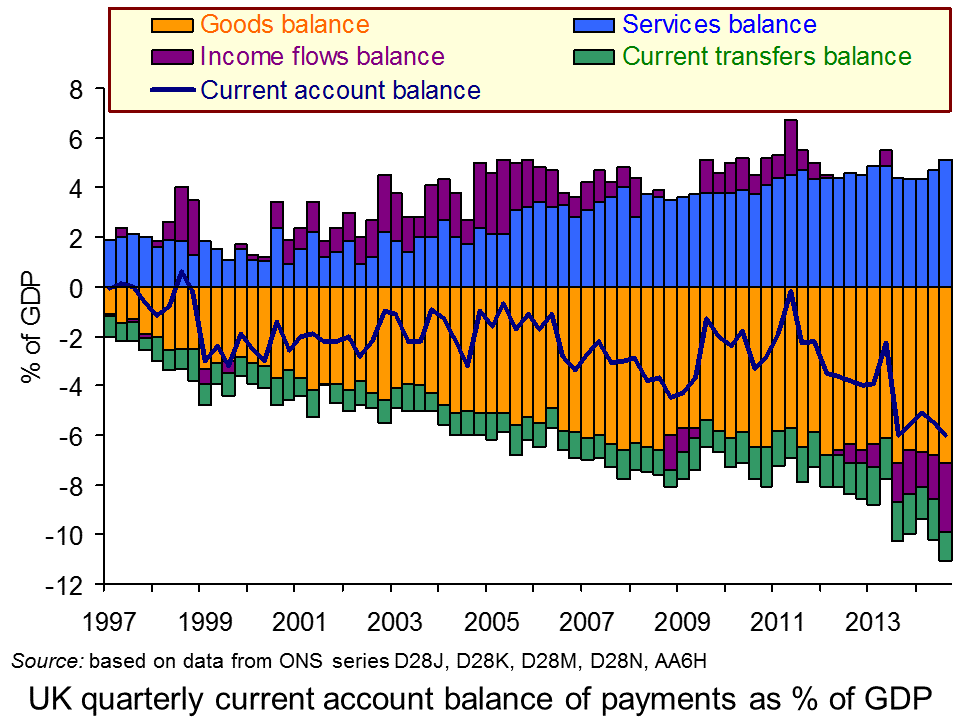 But what of the overall current account? Figures are at present available only up to 2014 Q3, but the picture is bleak (see the chart). As the ONS states:
But what of the overall current account? Figures are at present available only up to 2014 Q3, but the picture is bleak (see the chart). As the ONS states:
The current account deficit widened in Q3 2014, to 6.0% of nominal Gross Domestic Product GDP, representing the joint largest deficit since Office for National Statistics (ONS) records began in 1955.
This deterioration in performance can be partly attributed to the recent weakness in the primary income balance [see]. This also reached a record deficit in Q3 2014 of 2.8% of nominal GDP; a figure that can be primarily attributed to a fall in UK residents’ earnings from investment abroad, and broadly stable foreign resident earnings on their investments in the UK
The primary income account captures income flows into and out of the UK economy, as opposed to current transfers (secondary income) from taxes, grants, etc. The large deficit reflects a decline in the holding by UK residents of foreign assets from 92% of GDP in 2008 to 67% by the end of 2014. This, in turn, reflects the poorer rate of return on many of these assets. By contrast, the holdings of UK assets by foreign residents has increased. They have been earning a higher rate of return on these assets than UK residents have on foreign assets. And so, despite UK interest rates having fallen, as the quote above says, foreign residents’ earnings on their holding of UK assets has remained broadly stable.
Articles
UK trade deficit last year widest since 2010 BBC News (6/2/15)
UK’s trade deficit widens to 2010 high as consumers take advantage of falling oil The Telegraph, Peter Spence (6/2/15)
UK trade deficit widens to four-year high The Guardian, Katie Allen (6/2/15)
UK trade deficit hits four-year high Financial Times, Ferdinando Giugliano (6/2/15)
Data
Balance of Payments ONS (topic link)
Summary: UK Trade, December 2014 ONS (6/2/15)
Current account, income balance and net international investment position ONS (23/1/15)
Pink Book – Tables ONS
Questions
- Distinguish between he current account, the capital account and the financial account of the balance of payments.
- If the overall balance of payments must, by definition, balance, why does it matter if the following are in deficit: (a) trade in goods; (b) the current account; (b) income flows?
- What would cause the balance of trade deficit to narrow?
- Discuss what policies the government could pursue to reduce the size of the current account deficit? Distinguish between demand-side and supply-side policies.
- Why has the sterling exchange rate index been appreciating in recent months?
- What do you think is likely to happen to the sterling exchange rate index in the coming months? Explain.
 In an interview with the Yorkshire Post, Mark Carney, Governor of the Bank of England, said that under current circumstances he did not feel that further quantitative easing was justified. He said:
In an interview with the Yorkshire Post, Mark Carney, Governor of the Bank of England, said that under current circumstances he did not feel that further quantitative easing was justified. He said:
My personal view is, given the recovery has strengthened and broadened, I don’t see a case for quantitative easing and I have not supported it.
In response to his speech, the pound strengthened against the dollar. It appreciated by just over 1 cent, or 0.7%. But why should the likelihood of no further quantitative easing lead to a strengthening of the pound?
The answer lies with people’s anticipation of future interest rates. If there is no further increase in money supply through QE, interest rates are likely to rise as the economy recovers and thus the demand for money rises. 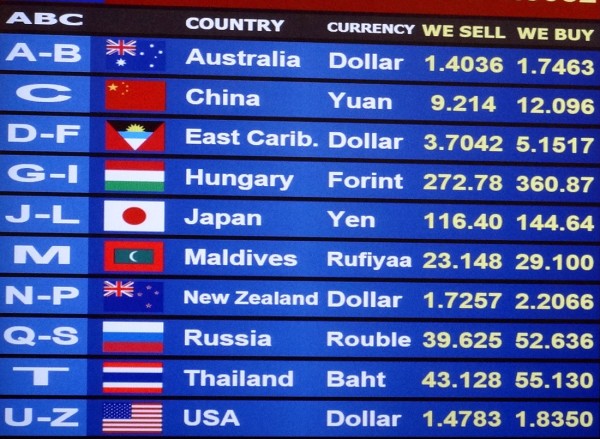 A rise in interest rates, in turn, is likely to lead to an inflow of finance into the country, thereby boosting the financial account of the balance of payments. The increased demand for sterling will tend to drive up the exchange rate.
A rise in interest rates, in turn, is likely to lead to an inflow of finance into the country, thereby boosting the financial account of the balance of payments. The increased demand for sterling will tend to drive up the exchange rate.
However, an increase in aggregate demand will result in an increase in imports and a likely increase in the balance of trade deficit. Indeed, in July (the latest figures available) the balance of trade deficit rose to £3.085bn from £1.256bn in June. As recovery continues, the balance of trade deficit is likely to deteriorate further. Other things being equal, this would lead to a depreciation of the pound.
So if the pound appreciates, this suggests that the effect on the financial account is bigger than the effect on the current account – or is anticipated to be so. In fact, given the huge volumes of short-term capital that move across the foreign exchanges each day, financial account effects of interest rate changes – actual or anticipated – generally outweigh current account effects.
Articles
Yorkshire can reap benefits from turnaround says Mark Carney Yorkshire Post (27/9/13)
Sterling Jumps as BOE Chief Signals No More Bond Buying Wall Street Journal, Nick Cawley and Jason Douglas (27/9/13)
Carney’s Northern Exposure Sends Sterling Soaring Wall Street Journal, David Cottle (27/9/13)
Pound Gains as Carney Sees No Case for QE, Confidence Improves Bloomberg, Anchalee Worrachate & David Goodman (28/9/13)
Exchange Rate Bounces as Strong UK Data Supports Sterling FCF (Future Currency Forecast), Laura Parsons (30/9/13)
Currency briefing: What if the pound sterling has been overbought? iNVEZZ, Tsvyata Petkova (30/9/13)
Pound rises after Carney rejects increasing QE BBC News (27/9/13)
Pound Rises for Fourth Day Versus Euro on Housing, Mortgage Data Bloomberg, Emma Charlton (30/9/13)
Data
$ per £ exchange rate (latest month) XE (You can access other periods and currencies)
Effective exchange rate indices (nominal and real) Bank for International Settlements
Balance of Payments, Q2 2013 Dataset ONS
Questions
- Explain how quantitative easing affects exchange rates.
- What is happening concerning quantitative easing in the USA? How is this likely to affect the exchange rate of the US dollar to sterling; other currencies to sterling?
- Why may an increase in the balance of trade deficit lead directly to an appreciation of the exchange rate?
- Why is an anticipation of a policy change likely to have more of an effect on exchange rates than the actual policy change itself? Why, indeed, may a policy change have the reverse effect once it is implemented?
- Under what circumstances may speculation against exchange rate changes be (a) stabilising; (b) destabilising?
- How is quantitative easing (or an anticipation of it) likely to affect each of the main components of the current and financial accounts of the balance of payments?
- For what reasons might sterling have been ‘overbought’ and hence be overvalued?
- What is meant by the real exchange rate (REER)? Why may reference to the REER suggest that sterling is not currently overvalued?
 The new Japanese government under Shinzo Abe, which took office on 26 December 2012, has been pursuing a policy of weakening the yen. Using a combination of low interest rates, quantitative easing, expansionary fiscal policy and a declared aim of depreciation, the government has succeeded in driving down the value of the yen.
The new Japanese government under Shinzo Abe, which took office on 26 December 2012, has been pursuing a policy of weakening the yen. Using a combination of low interest rates, quantitative easing, expansionary fiscal policy and a declared aim of depreciation, the government has succeeded in driving down the value of the yen.
Since mid-November last year, the yen has depreciated by 28% against the dollar, 30% against the euro and 21% against sterling. The effective exchange rate index has fallen by 22% (see first diagram below: click here for a PowerPoint of the diagram).
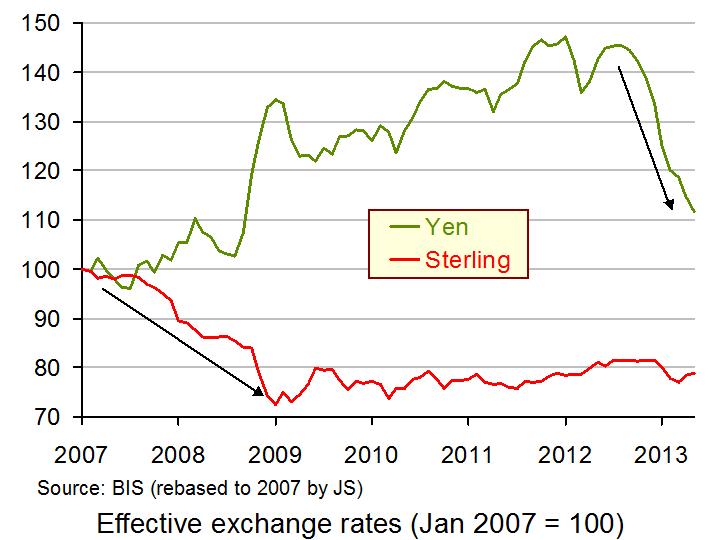 But will this depreciation succeed in stimulating the Japanese economy and will it improve the balance of trade? The hope is that the falling yen will boost export sales by making them cheaper abroad, and will reduce the demand for imports by making them more expensive in Japan. The balance of trade will thereby improve and higher exports (an injection) and lower imports (a withdrawal) will stimulate aggregate demand and economic growth.
But will this depreciation succeed in stimulating the Japanese economy and will it improve the balance of trade? The hope is that the falling yen will boost export sales by making them cheaper abroad, and will reduce the demand for imports by making them more expensive in Japan. The balance of trade will thereby improve and higher exports (an injection) and lower imports (a withdrawal) will stimulate aggregate demand and economic growth.
Traditionally Japan has run balance of trade surpluses, but since July 2012, it has been running monthly deficits – the longest run of deficits since 1980. But depreciation cannot be expected to turn this position around immediately. Indeed, theory suggests that the balance of trade is likely to deteriorate before it improves. This is known as the J-curve effect and is illustrated in the second diagram below. As page 768 of Economics, 8th edition states:
 At first a devaluation or depreciation might make a current account deficit worse: the J-curve effect. The price elasticities of demand for imports and exports may be low in the short run (see Case Study 25.1 in MyEconLab). Directly after devaluation or depreciation, few extra exports may be sold, and more will have to be paid for imports that do not have immediate substitutes. There is thus an initial deterioration in the balance of trade before it eventually improves. In Figure 25.12 [the second diagram], devaluation takes place at time t1. As you can see, the diagram has a J shape.
At first a devaluation or depreciation might make a current account deficit worse: the J-curve effect. The price elasticities of demand for imports and exports may be low in the short run (see Case Study 25.1 in MyEconLab). Directly after devaluation or depreciation, few extra exports may be sold, and more will have to be paid for imports that do not have immediate substitutes. There is thus an initial deterioration in the balance of trade before it eventually improves. In Figure 25.12 [the second diagram], devaluation takes place at time t1. As you can see, the diagram has a J shape.
Evidence suggests that the first part of the ‘J’ has been experienced in Japan: Japan’s balance of trade has deteriorated. But there is debate over whether the balance of trade will now start to improve. As the article by James Saft states:
But a look at the actual data shows Japanese companies, like British ones during a similar bout of currency weakness in 2008, appear to be more eager to use a newly competitive currency to pad profits through higher margins rather than higher export volumes. Thus far, Japanese exporters appear to be doing just that. Despite yen falls the price of Japanese exports in local currency has barely budged.
“Japanese companies have not actually cut the foreign currency prices of their exports. Just as with the UK exporters, the Japanese have chosen to hold foreign prices constant, maintain market share, and increase the yen value and thus the yen profit associated with yen depreciation,” UBS economist Paul Donovan writes in a note to clients.
 The extra profits earned by Japanese companies from export sales may be stockpiled or paid out in dividends rather than reinvested. And what investment does take place may be abroad rather than in Japan. The net effect may be very little stimulus to the Japanese economy.
The extra profits earned by Japanese companies from export sales may be stockpiled or paid out in dividends rather than reinvested. And what investment does take place may be abroad rather than in Japan. The net effect may be very little stimulus to the Japanese economy.
As stated by Saft above, the UK had a similar experience in the period 2007–9, when sterling depreciated some 27% (see the second diagram). The balance of trade improved very little and UK companies generally priced goods to markets abroad rather than cutting overseas prices.
But times were different then. The world was plunging into recession. Now global markets are mildly growing or static. Nevertheless, there is a danger that the upward slope of the J-curve in Japan may be pretty flat.
Articles
Weak yen a boon for investors, not Japan Reuters, James Saft (14/5/13)
Japan’s Trade Data Suggest Even Lower Yen Needed Wall Street Journal, Nick Hastings (22/5/13)
2 Misunderstandings About Japanese Trade Seeking Alpha, Marc Chandler (22/5/13)
Japanese trade deficit widens Financial Times, Ben McLannahan (22/5/13)
Data
BIS effective exchange rate indices Bank for International Settlements
Japan’s balance of trade Trading Economics
UK Trade, March 2013 ONS
Questions
- Explain the J-curve effect.
- Why is there some doubt about whether the Japanese balance of trade will improve significantly?
- What will be the consequences for Japanese growth?
- If foreign currency prices of Japanese exports do not change, what will determine the amount that Japan exports?
- What other measures is the Japanese government taking to stimulate the economy? What will determine the size of the multiplier effects of these measures?
- Using data from the ONS plot the UK’s quarterly balance of trade figures from 2007 to the present day. Explain the pattern that emerges.
 In the blog No accounting for trade, the rise in the UK’s balance of trade deficit was discussed. Many factors have contributed to this weakening position and no one market is to blame. But, by analysing one product and thinking about the factors that have caused its export volumes to decline, we can begin to create a picture not just of the UK economy (or more particularly Scotland!), but of the wider global economy.
In the blog No accounting for trade, the rise in the UK’s balance of trade deficit was discussed. Many factors have contributed to this weakening position and no one market is to blame. But, by analysing one product and thinking about the factors that have caused its export volumes to decline, we can begin to create a picture not just of the UK economy (or more particularly Scotland!), but of the wider global economy.
Scotch whisky may not have been the drink of choice for many British adults, but look outside Great Britain and the volume consumed is quite staggering. For example, French consumers drink more Scotch whisky in one month than they drink cognac in one year. The volume of Scotch whisky exported from our shores was £4.23 billion for 2011, accounting for 90% of all sales and making its way into 200 markets. However, one problem with this product is that it is highly susceptible to the business cycle. Add to this the time required to produce the perfect Scotch (in particular the fact that it must be left to mature) and we have a market where forecasting is a nightmare.
Producers typically look to forecast demand some 10 years ahead and so getting it right is not always easy, especially when the global economy declines following a financial crisis! So what has been the impact on exports of this luxurious drink? In the past few years, it has been as key growth market for UK exports rising by 190% in value over the past decade. But in 2012 the volume of Scotch whisky exports fell by 5% to 1.19 billion bottles. What explains the decline in sales?
The biggest importer of Scotch whisky is France and its volumes were down by 25%. Part of this decline is undoubtedly the economic situation. When incomes decline, demand for normal goods also falls. Many would suggest Scotch whisky is a luxury and thus we would expect to see a relatively large decline following any given fall in income. However, another factor adding to this decline in 2012 is the increased whisky tax imposed by the French government. Rising by 15% in 2012, commentators suggest that this caused imports of Scotch whisky to rise in 2011 to avoid this tax, thus imports in 2012 took a dive. Spain is another key export market and its economic troubles are clearly a crucial factor in explaining their 20% drop in volume of Scotch whisky imported.
But, it’s not all bad news: sales to Western Europe may be down, but Eastern Europe and other growth countries/continents, such as the BRICs and Africa have developed a taste for this iconic product. Latvia and Estonia’s value of Scotch whisky imports were up by 48% and 28% respectively, as Russian demand rises and China, still growing, is another key market. Gavin Hewitt, chief executive of the Scotch Whisky Association said:
A combination of successful trade negotations, excellent marketing by producers, growing demand from mature markets, particularly the USA, and the growing middle class in emerging economies helped exports hit a record £4.3bn last year.
Furthermore, while the volume of exports worldwide did fall, the value of these exports rose to £4.27 billion, a growth of 1%. This suggests that although we are exporting fewer bottles, the bottles that we are exporting are more expensive ones. Clearly some people have not felt the impact of the recession. For Scotland and the wider UK, these declining figures are concerning, but given the cyclical nature of the demand, as the world economy slowly begins to recover, sales are likely to follow suit. Gavin Hewitt continued his comments above, saying:
We are contributing massively to the Government’s wish for an export-led recovery. There is confidence in the future of the industry, illustrated by the £2bn capital investment that Scotch whisky producers have committed over the next three to four years.
The following articles consider the rise and fall of this drink and its role as a key export market across the world.
 Scottish whisky industry puts export hope in new market BBC News (2/4/13)
Scottish whisky industry puts export hope in new market BBC News (2/4/13)
Scotch whisky sales on the slide The Guardian, Simon Neville (2/4/13)
Growth stalls for Scotch whisky exports BBC News (2/4/13)
Scotch whisky accounts for 25pc of UK’s food and drink exports The Telegraph, Auslan Cramb (2/4/13)
Whisky sales fall but value of exports hits new high Herald Scotland (3/4/13)
Scotch whisky exports rise to record value The Telegraph, Auslan Cramb (2/4/13)
Scotch whisky exports hit by falling demand in France The Grocer, Vince Bamford (2/4/13)
New markets save Scotch from impact of austerity Independent, Tom Bawden (2/4/13)
Scotch exports hit by falling demand Financial Times, Hannah Kichler (2/4/13)
Questions
- Which is the better measure of an industry’s performance: the value or the volume of goods sold?
- Why would you expect volumes of Scotch sold to decline during an economic downturn?
- When a higher tax was imposed on Scotch whisky in France, why did volumes fall? Use a demand and supply diagram to illustrate the impact of the tax.
- What type of figure would you expect Scotch whisky to have for income elasticity of demand? Does it vary for different people?
- Why is forecasting demand for Scotch so difficult? What techniques might be used?
- Why does demand for Scotch whisky remain high and even rising in many emerging markets?
- Is the market for Scotch whisky exports a good indication of the interdependence of countries across the world?
 The UK economy shrank by 0.3 per cent in the final quarter of 2012. A significant factor in the fall was the UK’s balance of trade, which measures the difference between the value of goods and services exported and those imported. The balance of trade deficit rose in 2012 to £36.2 billion or 2.3 per cent of GDP. If we measure only the balance in goods, the deficit was an eye-watering £106.3 billion – a record high for the UK. The balance of trade remains a drag on British growth.
The UK economy shrank by 0.3 per cent in the final quarter of 2012. A significant factor in the fall was the UK’s balance of trade, which measures the difference between the value of goods and services exported and those imported. The balance of trade deficit rose in 2012 to £36.2 billion or 2.3 per cent of GDP. If we measure only the balance in goods, the deficit was an eye-watering £106.3 billion – a record high for the UK. The balance of trade remains a drag on British growth.
The balance of payments is a record all the flows of money between a country’s residents and the rest of the world. Inflows represent credits on the balance of payments while outflows represent debits. We focus here on perhaps the best-known component of the overall balance of payments: the current account. The current account comprises three separate accounts. First, there is the balance of trade (in goods and services). It records payments for exports (X) and imports (M). Second, there is net income flows. Net income flows are flows of money between countries in the form of wages, profits and interest. Finally, there is current transfers. Current transfers are transfers of money between countries for the purpose of consumption, including, for instance, a transfer payment by the British government to overseas organisations.
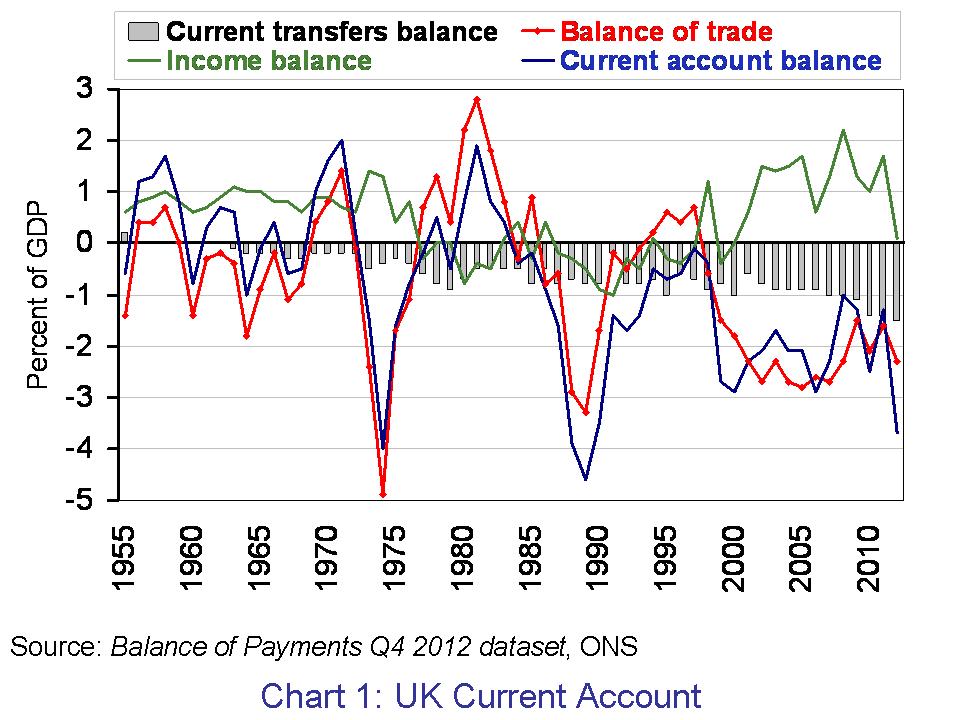
Chart 1 presents the UK’s current account. It is based on data from Balance of Payments Q4 2012 dataset published by the Office for National Statistics. The current account deficit in 2012 was £57.7 billion (up from a deficit of £20.2 billion in 2011). This is the equivalent to 3.7 per cent of GDP (up from a deficit of 1.3 per cent in 2011) and the highest current account deficit since 1989 when it reached 4.6 per cent of GDP. Back in 1989, the UK economy was growing by 2.6 per cent having grown by 5.6 per cent in 1988. In 2012, the UK economy grew by just 0.3 per cent following growth of 1.0 per cent in 2011. The mean average rate growth of the UK economy since 1950 is 2.6 per cent. (Click here for a PowerPoint of the chart.)
The net income balance, which while remaining in surplus, worsened significantly. From a surplus of £25.9 billion (1.7 per cent of GDP) in 2011, it fell to a surplus of just £1.6 billion (0.1 per cent of GDP) in 2012. This is largely attributable to a decline in the surplus of direct investment income and, in particular, the earnings abroad of non-bank private corporations. Meanwhile, the deficit on current transfers in 2012 was £23.1 billion, up from £22.0 billion in 2011. This is the highest on record. The current transfers deficit with EU institutions rose in 2012 to £10.5 billion, up by £1 billion on 2011.
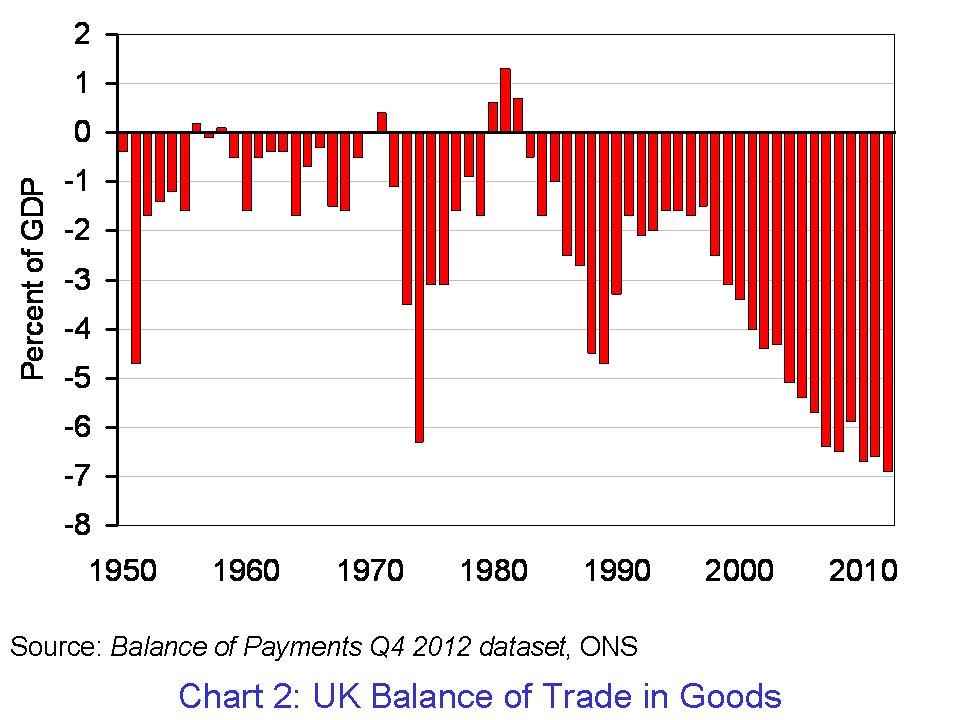
The balance of trade deficit too worsened in 2012. The deficit rose from £24.1 billion in 2011 (1.6 per cent of GDP) to £36.2 billion in 2012 (2.3 per cent of GDP). The persistent balance of trade deficit continues to occur despite a persistent surplus on the trade in services. In 2012, the balance of trade surplus in services was £70 billion (4.6 per cent of GDP). As Chart 2 shows, the UK now has a record deficit in the balance of trade in goods. This was down from £76.1 billion in 2011 (5 per cent of GDP). (Click here for a PowerPoint of the chart.)
The last time the UK ran a surplus on the balance of trade in goods was back in 1982. Since 1983, the average UK balance of trade deficit in goods has been the equivalent of 3.67 per cent of GDP. Over the same period, the UK has run a balance of trade surplus in services of 2.37 per cent. The figures point very clearly to the work to be done if we are to see a rebalancing of the industrial composition of the UK economy.
Data
Statistical Bulletin: Balance of Payments, Q4 2012 ONS, 27 March 2013
Balance of Payments, Q4 2012 dataset ONS, 27 March 2013
Articles
Fasten your seat belts – a balance of payments crisis looms Telegraph, Jeremy Warner 27/3/13)
Britain, the world and the end of the free lunch? BBC News, Stephanie Flanders (27/3/13)
March of the makers? Balance of payments figures make dismal reading Guardian, Larry Elliott (27/3/13)
Britain’s current account deficit at worst level since 1989 Guardian, Phillip Inman (27/3/13)
Pound fears as current account deficit jumps to near 25 per cent high Telegraph, Szu Ping Chan (27/3/13)
Current account deficit highest since 1989 Financial Times, Claire Jones (27/3/13)
Questions
- What does the balance of payments measure?
- In explaining what the current account of the balance of payments measures, distinguish between the three principal accounts comprising the current account.
- Why might we expect the current account to worsen when economic growth is strongest and improve when economic growth is weakest? Is this what we observe in the UK?
- The UK has experienced a persistent current account deficit since the early 1980s. What might be some of the contributory factors to this persistent deficit?
- How might we expect a country’s exchange rate to be affected by movements on the balance of payments?
 Newspaper headlines this week read that the UK’s balance of trade deficit has widened to £34.8bn, the largest since 2010. And when you exclude services, the trade in goods deficit, at £119.9bn is the largest ever in nominal terms and is also likely to be the largest as a percentage of GDP.
Newspaper headlines this week read that the UK’s balance of trade deficit has widened to £34.8bn, the largest since 2010. And when you exclude services, the trade in goods deficit, at £119.9bn is the largest ever in nominal terms and is also likely to be the largest as a percentage of GDP. But what of the overall current account? Figures are at present available only up to 2014 Q3, but the picture is bleak (see the chart). As the ONS states:
But what of the overall current account? Figures are at present available only up to 2014 Q3, but the picture is bleak (see the chart). As the ONS states:









